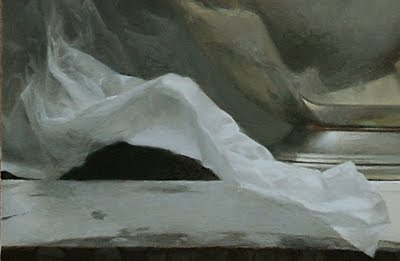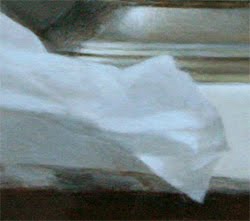"Black Jug" Sessions 7-11
 Friday, October 1, 2010 at 12:11AM
Friday, October 1, 2010 at 12:11AM This is the final stage of the painting I have been documenting step-by step.
Location:
3265 17th St, cross street Mission
San Francisco
For posts 2006-2010
please visit
sadievaleri.blogspot.com
Sadie’s current site is at
SadieValeriAtelier.com
UPDATE February 1, 2021
I have recently discovered that unfortunately this Squarespace blog has failed to maintain most the images for older posts on this blog. Luckily, the original Blogger version is still live at sadievaleri.blogspot.com and all the posts and images from 2006-2010 are still visible there.
For my current artwork, teaching, and blog please visit Sadie Valeri Atelier.
 Friday, October 1, 2010 at 12:11AM
Friday, October 1, 2010 at 12:11AM Location:
3265 17th St, cross street Mission
San Francisco
 Friday, October 1, 2010 at 12:07AM
Friday, October 1, 2010 at 12:07AM They seem to tell a story together, of secrets and memories, but we are not sure what it is. These objects seemed to arrange themselves on my shelf, and demand their story be told.
But what I did not realize when I set out to paint this, was what a challenge the glass bottle would turn out to be! What our mind tells us is a solid glass vessel with weight and symmetry, is actually only an arrangement of reflections superimposed on the background. One small mis-step of the brush or the eye, and the reflection wavers and the integrity of the bottle is lost.
Making this ephemeral illusion stand straight and symmetrical was a challenge, it only wanted to lean and warp! But I finally managed to nudge it into a position of solid grandeur, bravely holding its fragment of a note.
 Tuesday, September 14, 2010 at 1:19PM
Tuesday, September 14, 2010 at 1:19PM From here on out, the steps between stages will be incremental, hardly even noticeable in the photos posted here. But I'll try to post close-ups and describe what I am doing as much as possible.
 Tuesday, September 14, 2010 at 1:13PM
Tuesday, September 14, 2010 at 1:13PM So here I am mixing my values with colored pigment instead of just grey. I'm also just starting to warm up the colors of the shell, message paper and tissue.
Finally, I am adding a new level of refinement and detail as I make my first pass of color.
 Tuesday, September 14, 2010 at 1:06PM
Tuesday, September 14, 2010 at 1:06PM The main difference between painting with monochromatic values and painting is color is in the transitions between light and shadow. In monochrome, you can just mix a bit of the 'light" puddle with a bit of the "shadow" puddle to make the halftone between.
When painting in color, the "halftones" is where all the most saturated color is. So each step between the light and shadow must be analyzed and mixed to match a hue/color, in addition to the value. This is very subtle when painting a monochromatic subject in color, because all the hues are relatively desaturated. But it's what makes even a monochromatic subject look like it is "in color".
Also, even in sharp edges, like where the edges of the white seashell touch the black background of the pot, the paint will look chalky and clunky. The tiny seam where the white meets the black must be knit together with a deeply saturated, dark orange or red. Otherwise the white seashell will look like a cookie-cutter shape pasted over the background, instead of a believable object sharing the same reality as the jug.
To do this, I use a small brush to push rich, saturated mixtures into the edges of the shell, and then back-fill the seashell with white, leaving a tiny thread of color between the light edge and the black background.
Since this technique is subtle and microscopic, it's impossible to see the effect in this photo. But careful attention to the reality of the edges will make the painting look believable in person.
 Wednesday, September 1, 2010 at 2:46PM
Wednesday, September 1, 2010 at 2:46PM  Wednesday, September 1, 2010 at 2:44PM
Wednesday, September 1, 2010 at 2:44PM  Wednesday, September 1, 2010 at 2:43PM
Wednesday, September 1, 2010 at 2:43PM  Wednesday, September 1, 2010 at 2:41PM
Wednesday, September 1, 2010 at 2:41PM  Wednesday, September 1, 2010 at 2:39PM
Wednesday, September 1, 2010 at 2:39PM  Sunday, June 27, 2010 at 11:14PM
Sunday, June 27, 2010 at 11:14PM Just finished this little painting today after working on it on and off over the last month or 2 between other projects. I painted it over about 7 sessions. It developed a bit differently from my usual process for still life, because instead of doing a drawing first I just jumped in with a color oil sketch the first day, and just kept adding refinement and detail each session.
 Wednesday, February 10, 2010 at 10:53PM
Wednesday, February 10, 2010 at 10:53PM 
See previous post about this painting

Over the last month blogging has taken a backseat to finishing the final paintings for my upcoming show at M Gallery in Florida, also setting up my new studio, starting private classes and workshops at the new studio, and teaching MFA candidates one day a week at the Academy of Fine Art.
Phew!
Oh, and I also started an amazing, inspiring ecorche class (sculpting all the bones and muscles of the human body in clay) with Andrew Ameral, master anatomy teacher from the Florence Academy.
 Wednesday, February 10, 2010 at 10:45PM
Wednesday, February 10, 2010 at 10:45PM This painting and 5 others will be at my show at M Gallery in Sarasota, Florida for the month of March, opening March 5.
 Thursday, December 24, 2009 at 1:10AM
Thursday, December 24, 2009 at 1:10AM  Wednesday, December 9, 2009 at 4:51PM
Wednesday, December 9, 2009 at 4:51PM 
Sign up for my mailing list to be notified when I post photos of the new studio, new artwork, and upcoming art classes.
 Wednesday, December 2, 2009 at 9:57PM
Wednesday, December 2, 2009 at 9:57PM 
 Tuesday, December 1, 2009 at 8:48PM
Tuesday, December 1, 2009 at 8:48PM 
 Monday, November 30, 2009 at 7:30PM
Monday, November 30, 2009 at 7:30PM 

------UPCOMING CLASSES AND WORKSHOPS-----------
I teach Classical Realism drawing and painting classes and workshops in my north light San Francisco studio. I also offer workshops at other locations in the US. Please visit my Teaching page for more information and to register!
 Sunday, November 29, 2009 at 9:12PM
Sunday, November 29, 2009 at 9:12PM 
In yesterday's post I mentioned "value bracketing" and got a lot of questions about that.

To capture the sensation of seeing a subject, the artist must preserve the feeling of the whole - how every part relates to every other part. This is so easy to destroy as we zoom in and work closely, because we lose context and we forget that the individual parts, no matter how detailed or realistic, are merely supporting roles to the whole effect.
 Saturday, November 28, 2009 at 7:21PM
Saturday, November 28, 2009 at 7:21PM 
Painting is 99% drawing by the way. I never believed it more than I believe it now. If you want to be a better painter, study more drawing. I am amazed by how the same principles I teach the most beginning drawing student are the principles I must hold as my mantra all day every day: Look for the large shapes, bracket the values, work large to small and from shadow up to light...